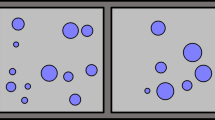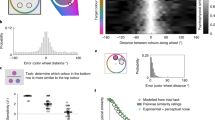Abstract
Size constancy is a term used to refer to the fact that objects seem to maintain size as their distance from an observer changes, despite change in image size. it is known that size constancy has limits1,2. People seen from the top of tall buildings look small. By observing objects, including the Moon, and after-images, we demonstrate here that size constancy holds when image size is above half a degree, and breaks down when it is less. In other words, image size is scaled for distance only when image size is above half a degree.
This is a preview of subscription content, access via your institution
Access options
Subscribe to this journal
Receive 51 print issues and online access
$199.00 per year
only $3.90 per issue
Buy this article
- Purchase on Springer Link
- Instant access to full article PDF
Prices may be subject to local taxes which are calculated during checkout
Similar content being viewed by others
References
Descartes, R. Meditations on First Philosophy, Sixth meditation (1642).
Helmholtz, H. von Treatise on Physiological Optics Vol. 3 (ed. Southall, J.P.C.) 283 (Dover, New York, 1925).
Emmert, E. Klin. Mbl. Angenheilk. 19, 443 (1881).
Rock, I. & Kaufman, L. Science 136, 1023 (1962).
Campbell, F. W., Johnstone, J. R. & Ross, J. Vision Res. (submitted).
Johnstone, J. R., Ross, J. & Campbell, F. W. Proc. Aust. physiol. pharmac. Soc. 10, 114 (1979).
Author information
Authors and Affiliations
Rights and permissions
About this article
Cite this article
Ross, J., Jenkins, B. & Johnstone, J. Size constancy fails below half a degree. Nature 283, 473–474 (1980). https://doi.org/10.1038/283473a0
Received:
Accepted:
Issue Date:
DOI: https://doi.org/10.1038/283473a0
This article is cited by
-
Studies of the Perception of Incomplete Outline Images of Different Sizes
Neuroscience and Behavioral Physiology (2009)
-
Foraging behaviour in fishes: perspectives on variance
Environmental Biology of Fishes (1986)
-
Motorbike safety
Nature (1981)
-
Size constancy does not fail below half a degree
Nature (1981)
Comments
By submitting a comment you agree to abide by our Terms and Community Guidelines. If you find something abusive or that does not comply with our terms or guidelines please flag it as inappropriate.



